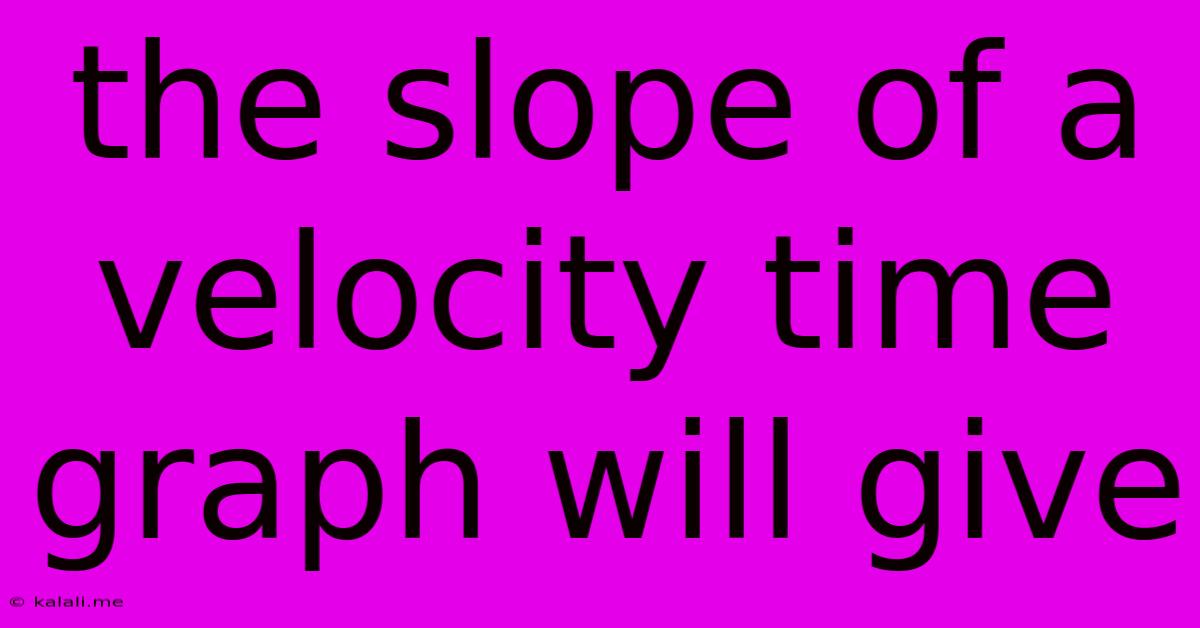The Slope Of A Velocity Time Graph Will Give
Kalali
Jun 13, 2025 · 3 min read

Table of Contents
The Slope of a Velocity-Time Graph: Unveiling Acceleration
The slope of a velocity-time graph provides crucial information about an object's motion: it reveals the acceleration. This seemingly simple concept is fundamental to understanding kinematics and forms the basis for many more complex physics calculations. This article delves into the details of interpreting velocity-time graphs, explaining how to calculate acceleration and what different slopes signify.
Understanding the relationship between velocity, time, and acceleration is key to mastering introductory physics. This is precisely what a velocity-time graph helps us visualize.
What is a Velocity-Time Graph?
A velocity-time graph plots an object's velocity (usually in meters per second or m/s) on the y-axis against time (usually in seconds or s) on the x-axis. Each point on the graph represents the object's velocity at a specific time. The graph's shape reveals vital information about the object's movement.
Calculating Acceleration from the Slope
The slope of a line on a graph is defined as the change in the y-axis value divided by the change in the x-axis value. In the context of a velocity-time graph:
Slope = (Change in Velocity) / (Change in Time)
Since the change in velocity over time is the definition of acceleration, the slope of the velocity-time graph directly represents the acceleration of the object. A steeper slope indicates a greater acceleration, while a shallower slope indicates a smaller acceleration.
Interpreting Different Slopes
Several scenarios can be interpreted from the slope of a velocity-time graph:
-
Positive Slope: A positive slope indicates positive acceleration. This means the object's velocity is increasing over time. The object is speeding up.
-
Negative Slope: A negative slope indicates negative acceleration (also known as deceleration or retardation). This means the object's velocity is decreasing over time. The object is slowing down.
-
Zero Slope: A zero slope (a horizontal line) indicates zero acceleration. This means the object's velocity is constant over time. The object is moving at a constant speed.
Beyond Straight Lines: Understanding Curves
While the above examples focus on straight lines, velocity-time graphs often depict curves. A curved line indicates a changing acceleration. The instantaneous acceleration at any point on the curve can be found by calculating the slope of the tangent line at that point. This requires a more advanced understanding of calculus, specifically derivatives.
Practical Applications and Examples
Understanding velocity-time graphs has numerous practical applications, including:
- Analyzing vehicle motion: Determining the acceleration of a car during braking or acceleration.
- Studying projectile motion: Analyzing the vertical and horizontal components of an object's velocity.
- Understanding free fall: Analyzing the acceleration due to gravity.
By mastering the interpretation of velocity-time graphs, you unlock a powerful tool for understanding and analyzing motion in physics. The slope, representing acceleration, is the key to unlocking this understanding, allowing for a deeper comprehension of the dynamics of movement. Remember that understanding the concept of instantaneous acceleration, using tangents to curves, is an important next step in furthering your knowledge of kinematics.
Latest Posts
Latest Posts
-
What Is The Smallest Functional Unit Of The Kidney
Jun 14, 2025
-
According To Bronfenbrenners Ecological Systems Theory
Jun 14, 2025
-
Which Of The Following Statements Regarding Earthquake Waves Is Correct
Jun 14, 2025
-
5 14 41 No Mans Sky
Jun 14, 2025
-
What Can You Multiply To Get 32
Jun 14, 2025
Related Post
Thank you for visiting our website which covers about The Slope Of A Velocity Time Graph Will Give . We hope the information provided has been useful to you. Feel free to contact us if you have any questions or need further assistance. See you next time and don't miss to bookmark.